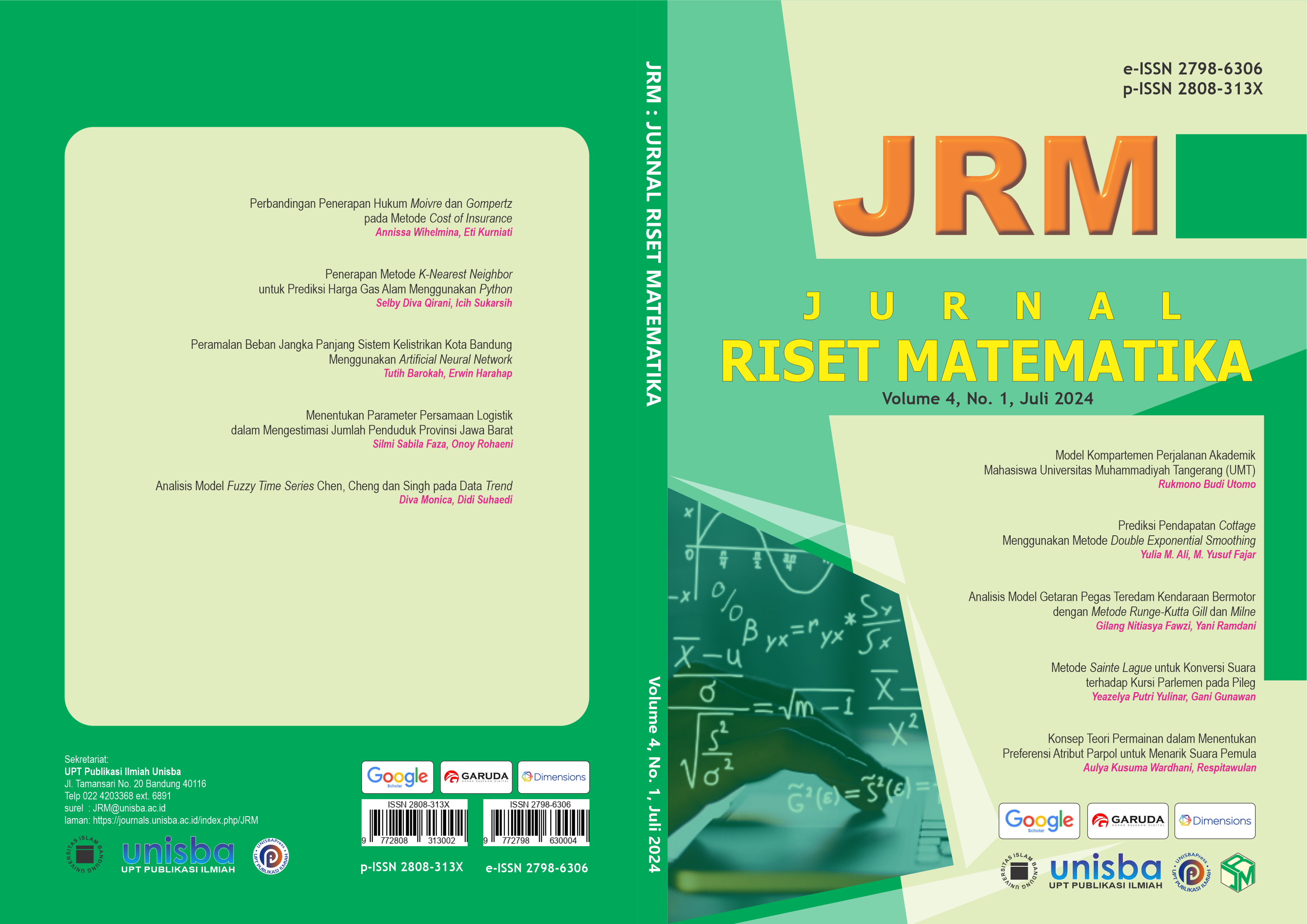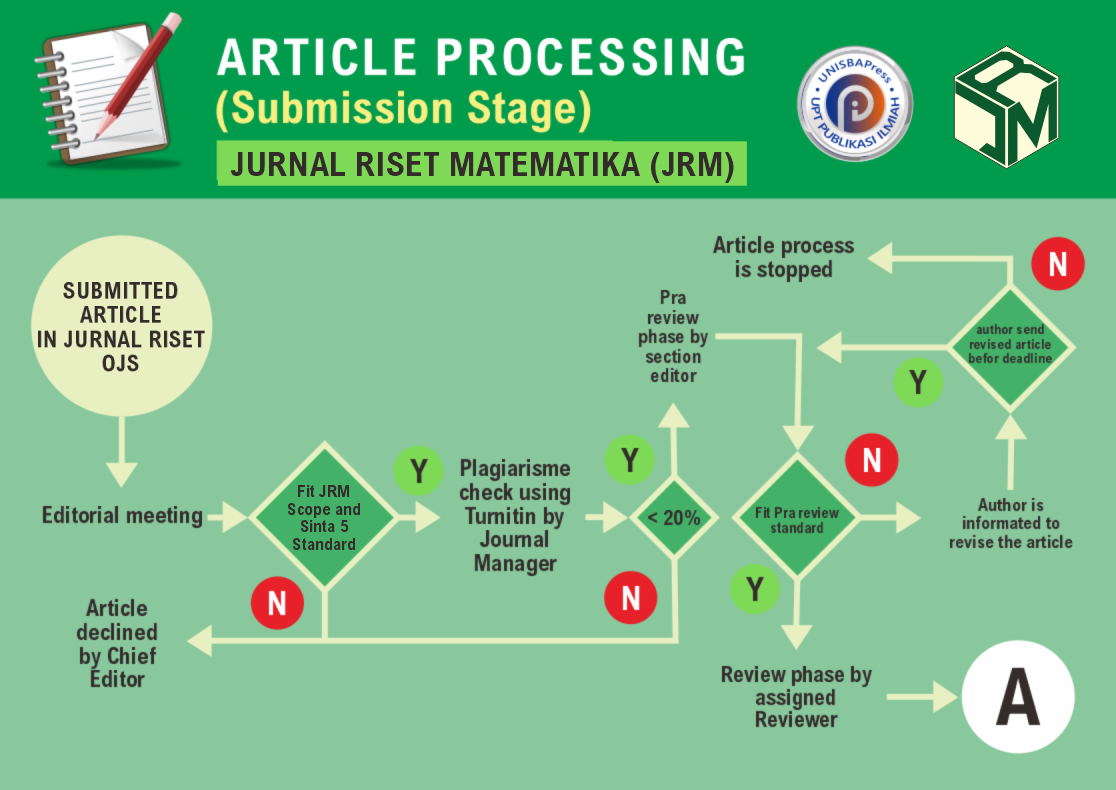Model Kompartemen Perjalanan Akademik Mahasiswa Universitas Muhammadiyah Tangerang (UMT)
DOI:
https://doi.org/10.29313/jrm.v4i1.3441Keywords:
PemodelanAbstract
Abstrak. Paper ini hasil penelitian perjalanan akademik mahasiswa Universitas Muhammadiyah Tangerang (UMT). Latar belakang penelitian ini didasari perjalanan studi mahasiswa UMT dibagi atas tiga bagian, yakni mahasiswa pada semester awal, menengah dan akhir. Mahasiswa semester awal adalah mahasiswa yang baru bergabung yakni siswa lulusan SMA sederajat dan pindahan. Lebih lanjut mahasiswa semester menengah merupakan mahasiswa pada posisi semester 3-6 dan mahasiwa semester akhir yakni pada semester 7 dan 8. Pada kenyataanya pada semester awal mahasiswa dapat berkurang karena kematian. Pada semester menengah mahasiswa dapat berkurang karena DropOut (DO) dan kematian dan pada semester akhir mahasiswa dapat berkurang karena DO, kematian dan kelulusan. Tujuan penelitian ini untuk menggambarkan perjalanan mahasiswa UMT menggunakan model matematika. Asumsi yang digunakan di penelitian ini dianggap populasi bersifat tertutup pada tahap semester menengah dan akhir. Mahasiswa yang masuk di semester menengah berasal dari mahasiswa semester awal dan mahasiswa semester akhir berasal dari mahasiswa semester menengah. Metodologi pada penelitian ini mengacu pada sistem persamaan differensial. Hasil penelitian ini adalah mahasiswa yang masuk pada semester awal akan naik ke tingkat menengah dan akhirnya turun menjelang tingkat akhir. Mahasiswa semester menengah akan turun menjelang tingkat akhir dan mahasiswa tingkat akhir juga akan turun menjelang kelulusan.
Abstract. This article is an output of our research about phenomenon academic flow of students at UMT. Background of this research is the fact that the academic flow of university students divided as three clusters named Initial cluster, middle cluster and finish cluster. Initial cluster is a place that collected new students. Middle cluster is a place where the students is in range 3-6 semester, and the finish cluster is a place where the last students collected. In every single cluster, total of students can be reduce because any factor like dead, Drop Out (DO) and graduated. Based on that story, we the aim of this research is we are trying to formulating that phenomenon into mathematic model. For Methodology, We are using compartment model. We also representing the model into graphic time series. The result describe that the total student in initial cluster will increase into middle cluster and will be reduce at the end. Total students in middle cluster will be reduce at the end approach the last semester. Total students at finish cluster absolutely will be turn down before their graduated.
References
F. Rustam et al., “Vector mosquito image classification using novel RIFS feature selection and machine learning models for disease epidemiology,” Saudi J Biol Sci, vol. 29, no. 1, pp. 583–594, Jan. 2022, doi: 10.1016/j.sjbs.2021.09.021.
S. Side, A. Zaki, and Miswar, “Numerical Solution of the Mathematical Model of DHF Spread using the Runge-Kutta Fourth Order Method,” ARRUS Journal of Mathematics and Applied Science, vol. 2, no. 2, pp. 92–100, Apr. 2022, doi: 10.35877/mathscience745.
S. Side, dan Alvioni Bani, J. Matematika, and F. Matematika dan Ilmu Pengetahuan Alam, “Modifikasi Model SIR pada Penyebaran Penyakit Demam Berdarah Dengue di Kabupaten Bone,” 2018. [Online]. Available: http://www.ojs.unm.ac.id/jmathcos
F. Rustam et al., “Vector mosquito image classification using novel RIFS feature selection and machine learning models for disease epidemiology,” Saudi J Biol Sci, vol. 29, no. 1, pp. 583–594, Jan. 2022, doi: 10.1016/j.sjbs.2021.09.021.
S. Side, A. Zaki, and Miswar, “Numerical Solution of the Mathematical Model of DHF Spread using the Runge-Kutta Fourth Order Method,” ARRUS Journal of Mathematics and Applied Science, vol. 2, no. 2, pp. 92–100, Apr. 2022, doi: 10.35877/mathscience745.
S. Side, dan Alvioni Bani, J. Matematika, and F. Matematika dan Ilmu Pengetahuan Alam, “Modifikasi Model SIR pada Penyebaran Penyakit Demam Berdarah Dengue di Kabupaten Bone,” 2018. [Online]. Available: http://www.ojs.unm.ac.id/jmathcos
M. Z. Ndii, A. R. Mage, J. J. Messakh, and B. S. Djahi, “Optimal vaccination strategy for dengue transmission in Kupang city, Indonesia,” Heliyon, vol. 6, no. 11, Nov. 2020, doi: 10.1016/j.heliyon.2020.e05345.
M. Z. Ndii, “The effects of vaccination, vector controls and media on dengue transmission dynamics with a seasonally varying mosquito population,” Results Phys, vol. 34, Mar. 2022, doi: 10.1016/j.rinp.2022.105298.
H. R. Pandey, G. R. Phaijoo, and D. B. Gurung, “Vaccination effect on the dynamics of dengue disease transmission models in Nepal: A fractional derivative approach,” Partial Differential Equations in Applied Mathematics, vol. 7, Jun. 2023, doi: 10.1016/j.padiff.2022.100476.
M. A. Baihaqi, P. B. Al-Kubro, R. A. Andyani, Y. Setyawati, U. B. Rahayu, and M. Fitriyya, “Pola Penyebaran Penyakit Demam Berdarah dengan Model SIR di Madiun Tahun 2020-2022,” Jurnal Keilmuan dan Keislaman, pp. 1–9, Dec. 2023, doi: 10.23917/jkk.v3i1.171.
M. Soleh, J. Matematika, F. Sains dan Teknologi, U. H. Sultan Syarif Kasim Riau Jl Soebrantas No, and S. Baru, “MODEL SIR PENYEBARAN DEMAM BERDARAH DI PEKANBARU,” Jurnal Sains Matematika dan Statistika, vol. 4, no. 2, 2018.
W. Sanusi et al., “Analysis and Simulation of SIRS Model for Dengue Fever Transmission in South Sulawesi, Indonesia,” J Appl Math, vol. 2021, 2021, doi: 10.1155/2021/2918080.
D. Aldila, M. Z. Ndii, N. Anggriani, Windarto, H. Tasman, and B. D. Handari, “Impact of social awareness, case detection, and hospital capacity on dengue eradication in Jakarta: A mathematical model approach,” Alexandria Engineering Journal, vol. 64, pp. 691–707, Feb. 2023, doi: 10.1016/j.aej.2022.11.032.
S. Windawati, A. Shodiqin, and A. N. Aini, “Analisis Kestabilan Model Matematika Penyebaran Penyakit Demam Berdarah dengan Pengaruh Fogging,” Square : Journal of Mathematics and Mathematics Education, vol. 2, no. 1, p. 1, Apr. 2020, doi: 10.21580/square.2020.2.1.5149.
M. A. Khan and Fatmawati, “Dengue infection modeling and its optimal control analysis in East Java, Indonesia,” Heliyon, vol. 7, no. 1, Jan. 2021, doi: 10.1016/j.heliyon.2021.e06023.
L. Hu, M. Tang, Z. Wu, Z. Xi, and J. Yu, “The threshold infection level for Wolbachia invasion in random environments,” J Differ Equ, vol. 266, no. 7, pp. 4377–4393, Mar. 2019, doi: 10.1016/j.jde.2018.09.035.
A. Omame, U. K. Nwajeri, M. Abbas, and C. P. Onyenegecha, “A fractional order control model for Diabetes and COVID-19 co-dynamics with Mittag-Leffler function,” Alexandria Engineering Journal, vol. 61, no. 10, pp. 7619–7635, Oct. 2022, doi: 10.1016/j.aej.2022.01.012.
R. A. Hosny, R. Abu-Gdairi, and M. K. El-Bably, “Enhancing Dengue fever diagnosis with generalized rough sets: Utilizing initial-neighborhoods and ideals,” Alexandria Engineering Journal, vol. 94, pp. 68–79, May 2024, doi: 10.1016/j.aej.2024.03.028.
A. P. Mendoza, “Dengue incidence forecasting model in Magalang, Pampanga using time series analysis,” Inform Med Unlocked, vol. 44, Jan. 2024, doi: 10.1016/j.imu.2023.101439.
P. Chanprasopchai, I. M. Tang, and P. Pongsumpun, “SIR Model for Dengue Disease with Effect of Dengue Vaccination,” Comput Math Methods Med, vol. 2018, 2018, doi: 10.1155/2018/9861572.













